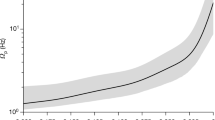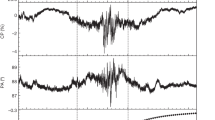Abstract
THE pulsar braking index, n, is a dimensionless quantity describing the rate at which a magnetized neutron star loses rotational energy1. It can be determined from pulsar timing measurements, and for distant pulsars is found to lie close to n = 3 (ref. 2), as predicted by theoretical models of pulsar emission mechanisms3–5. In contrast, the timing parameters—in particular the second derivative of the pulsation frequency—of the nearby pulsar Geminga6–11 indicate an extremely large braking index of about 10-30. To understand this property of Geminga, we consider here the effect on the measured timing parameters of a pulsar's motion through space. We find that the Doppler effect alone can give a high apparent braking index, but only if the pulsar is very close and has an abnormally high velocity (>1000kms-1). A more likely (but related) cause of the high braking index is the pulsar's proper motion: failure to correct for changes in the source coordinates with time can greatly influence the higher derivatives of the pulsar frequency, and lead to an erroneous value of n. A self-consistent analysis of the timing data, which account for both the proper motion and the Doppler effect, should permit a reliable estimate of the distance to Geminga.
This is a preview of subscription content, access via your institution
Access options
Subscribe to this journal
Receive 51 print issues and online access
$199.00 per year
only $3.90 per issue
Buy this article
- Purchase on Springer Link
- Instant access to full article PDF
Prices may be subject to local taxes which are calculated during checkout
Similar content being viewed by others
References
Manchester, R. N. & Taylor, J. H. Pulsars (Freeman, San Francisco, 1977).
Manchester, R. N., Durdin, J. M., & Newton, L. M. Nature 313, 374–376 (1985).
Pacini, F. Nature 216, 567–568 (1967).
Gunn, H. E. & Ostriker, J. P. Nature 221, 454–455 (1969).
Goldreich, P. & Julian, W. H. Astrophys. J. 157, 869–875 (1969).
Halpern, J. P. & Holt, S. S. Nature 357, 222–223 (1992).
Bertsch, D. L. et al. Nature 357, 306–307 (1992).
Bignami, F. G. & Caraveo, P. A. Nature 357, 287 (1992).
Mattox, J. R. et al. IAU Circ. No. 5583.
Mayer-Hasselwander, H. A. et al. IAU Circ. No. 5649.
Hermsen, W. et al. IAU Circ. No. 5541.
Shklovskij, I. S. Astr. Zh. 46, 715–719 (1969).
Bisnovatyi-Kogan, G. S. & Moiseenko, S. G. Astr. Zh. 69, 563–571 (1992).
Bisnovatyi-Kogan, G. S. Astr. Astrophys. Trans. 4, 287–294 (1993).
Frail, D. A. & Kulkarni, S. R. Nature 352, 785–787 (1991).
Harrison, P. A., Lyne, A. G. & Anderson, B. in Proc. NATO-ARW, X-ray Binaries and Recycled Pulsars (eds Van den Heuvel, E. & Rappaport, S.) 155–160 (Kluwer, Dordrecht, 1992).
Cordes, J. M., Romani, R. W. & Lundgren, S. C. Cornell Univ. preprint Dec. 1992.
Bignami, G. F., Caraveo, P. A., Paul, J. A., Salotti, L. & Vigroux, L. Astrophys. J. 319, 358–364 (1987).
Halpern, J. P. & Tytler, D. Astrophys. J. 330, 201–220 (1988).
Bignami, G. F., Caraveo, P. A. & Mereghetti, S. Nature 361, 704–707 (1993).
Author information
Authors and Affiliations
Rights and permissions
About this article
Cite this article
Bisnovatyi-Kogan, G., Postnov, K. Pulsar motion effect and Geminga's high braking index. Nature 366, 663–665 (1993). https://doi.org/10.1038/366663a0
Received:
Accepted:
Issue Date:
DOI: https://doi.org/10.1038/366663a0
Comments
By submitting a comment you agree to abide by our Terms and Community Guidelines. If you find something abusive or that does not comply with our terms or guidelines please flag it as inappropriate.



